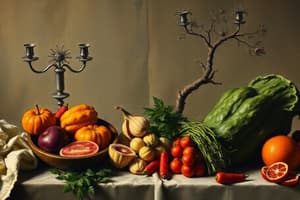Podcast
Questions and Answers
What is food history?
What is food history?
- The history of agriculture and farming practices
- The history of cooking techniques and recipes
- The study of food science and nutrition
- The study of the history of food and its cultural, economic, environmental, and sociological impacts (correct)
What was the role of the Church in controlling food consumption?
What was the role of the Church in controlling food consumption?
- Banning certain types of food
- Promoting a vegetarian diet
- Influencing people to have feasts throughout the year (correct)
- Encouraging people to fast
What was the impact of the Green Revolution?
What was the impact of the Green Revolution?
- Led to the development of fast food
- Introduced new foodstuffs to Europe
- Decreased agricultural production worldwide
- Increased agricultural production worldwide (correct)
What was the significance of the potato's introduction to Europe?
What was the significance of the potato's introduction to Europe?
What was the impact of the Portuguese and Spanish Empires on food exchange?
What was the impact of the Portuguese and Spanish Empires on food exchange?
What was the role of sugar in the 18th century?
What was the role of sugar in the 18th century?
What was the impact of Nazi Germany's food policies during World War II?
What was the impact of Nazi Germany's food policies during World War II?
What was the impact of the Jesuits on cuisine?
What was the impact of the Jesuits on cuisine?
What was the impact of Islamic cuisine on European cuisine during the Middle Ages and the Renaissance?
What was the impact of Islamic cuisine on European cuisine during the Middle Ages and the Renaissance?
Flashcards are hidden until you start studying
Study Notes
A Brief History of Food and its Impact on Society
- Food history is a field that examines the history of food, its cultural, economic, environmental, and sociological impacts, and human nutrition.
- The first journal on food history, Petits Propos Culinaires, was launched in 1979, and the first conference was held in 1981.
- Early human nutrition was largely determined by the availability and taste of foods. Humans evolved as omnivorous hunter-gatherers, and their diets varied depending on location and climate.
- Agriculture developed at different times in different places, providing some cultures with a more abundant supply of grains and potatoes, and the domestication of animals provided some cultures with milk and dairy products.
- The medieval cuisine in Western Europe did not change rapidly, with cereals remaining the most important staple, and meat being expensive and prestigious.
- Food consumption was controlled by geography, availability, and the Church, which influenced people to have feasts throughout the year.
- In the 16th century, the Portuguese and Spanish Empires opened up sea trade routes that linked food exchange across the world, which led to mixed cuisine between Portugal and Western India.
- The 18th century saw innovative farmers experimenting with new techniques and products, and sugar becoming a staple of working-class diets.
- The 19th century saw the introduction of new foodstuffs, especially fruit, and the rapid entry of entirely new items into American eating habits, firmly establishing fast food in the American culinary experience.
- During World War II, Nazi Germany tried to feed its population by seizing food supplies from occupied countries, and rationing in the United Kingdom was associated with an improvement in public health.
- The Green Revolution in the 1950s and 1960s was a technological breakthrough in plant productivity that increased agricultural production worldwide.
- The potato was first domesticated in the region of modern-day southern Peru and extreme northwestern Bolivia, and its introduction to Europe in the 16th century played a major role in the European population boom.
- Sugar originated from India and became more affordable during the Middle Ages, which allowed Europeans to enjoy Islamic-inspired confectionary goods that were previously costly to produce.
- Religion had a significant impact on cuisines, with the three most widespread religions (Christianity, Buddhism, and Islam) developing their own distinct recipes, cultures, and practices around food.Religious and societal views on killing living things for religious purposes have changed and it is no longer considered a major principle in most religions. Jewish cuisine is influenced by Jewish dietary laws, kashrut, and other religious requirements. Sephardic Jews migrated to North Africa and the Ottoman lands, blending Iberian cuisine with local cuisine. Many foods considered Jewish in the United States, such as bagels, knishes, and borscht are Eastern European Ashkenazi dishes. The Jesuits’ influence on cuisine differed from country to country. They were the leading producers and promoters of chocolate, and introduced several foods and cooking techniques to Japan. Chocolate was thought to have lust-reducing effects applicable to many nuns and monks at the time. The Jesuits exported sugar and cacao from the Americas to Europe, and in southern parts of the Americas, they dried leaves of the local mate plant that would compete with coffee, tea, and chocolate as the favored hot beverage in Europe. The significance of Islamic cuisine in Eurasia is noteworthy. In the Islamic world, cuisine has played a significant role in the development of the arts, sciences, and medicine. The Islamic world was the origin of several major crops, including sugarcane, rice, cotton, and citrus fruits. The Islamic world was also responsible for introducing spices, including cinnamon, ginger, and pepper, to the West. Islamic cuisine was also a significant influence on European cuisine during the Middle Ages and the Renaissance. The influence of Islamic cuisine can be seen in dishes such as the Spanish paella and the French bouillabaisse.
Studying That Suits You
Use AI to generate personalized quizzes and flashcards to suit your learning preferences.




